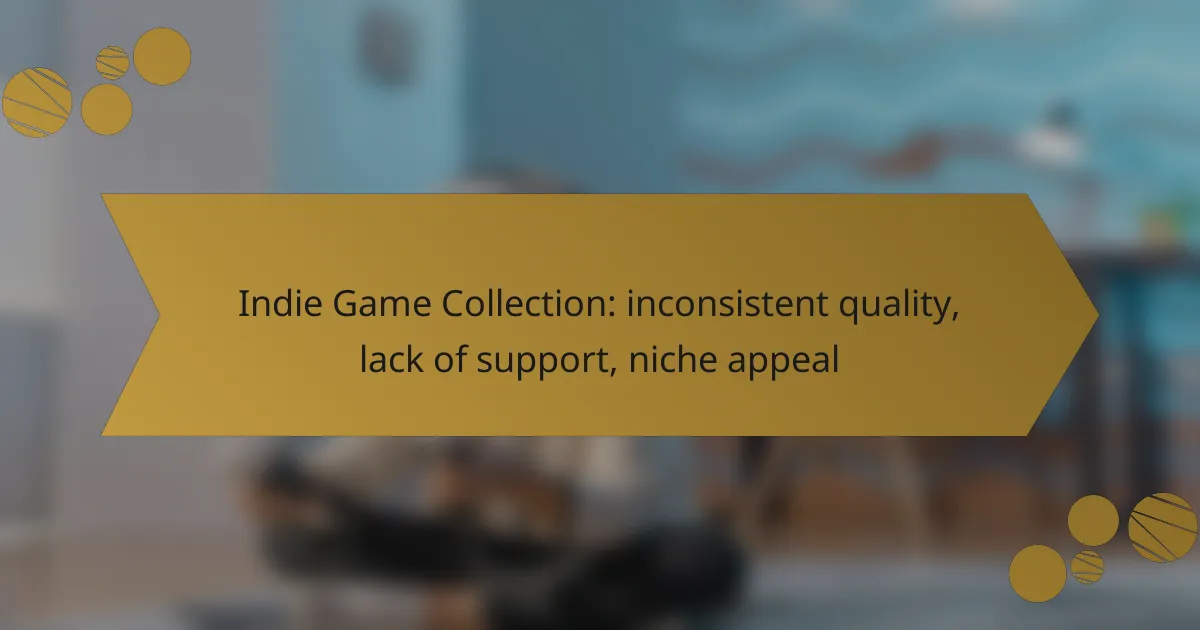The indie game landscape is characterized by a diverse collection of titles that often vary significantly in quality, leading to a mixed experience for players. While these games can offer unique and innovative gameplay, they frequently suffer from limited support and appeal to niche audiences. To navigate this space effectively, both developers and players must engage with community resources and adopt strategies that enhance game quality and visibility.
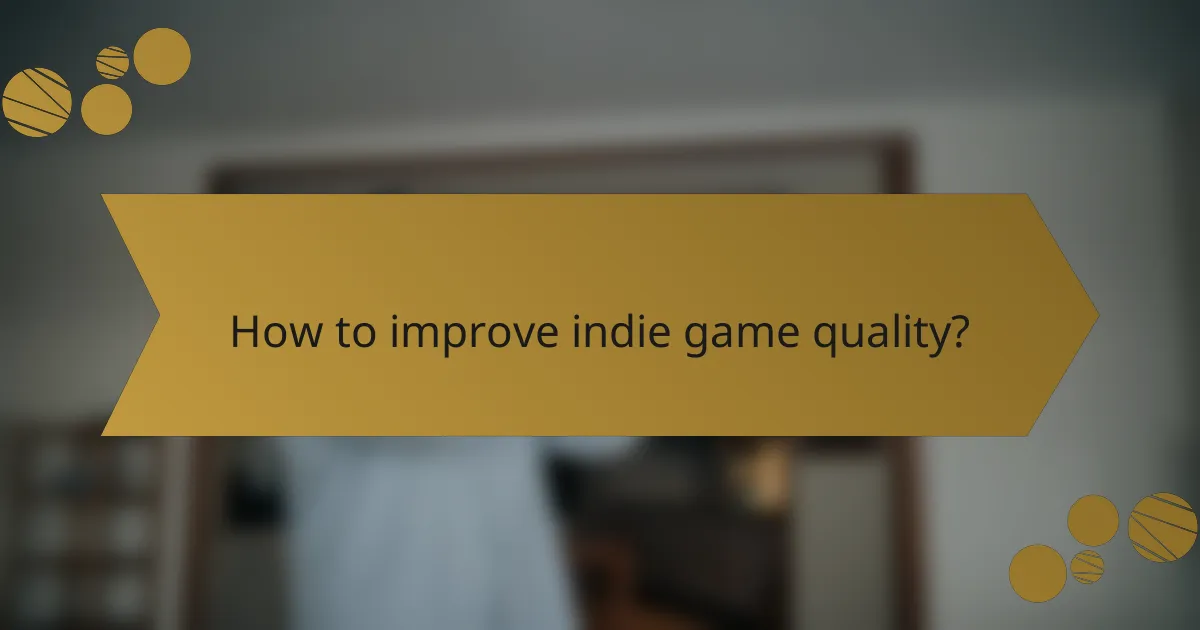
How to improve indie game quality?
Improving indie game quality involves implementing structured testing, engaging with the community, and adopting flexible development practices. These strategies help ensure that games meet player expectations and maintain a high standard of enjoyment.
Implement quality assurance testing
Quality assurance (QA) testing is crucial for identifying bugs and gameplay issues before release. Indie developers should consider both manual and automated testing methods to cover various aspects of the game, including performance, graphics, and user experience.
Establishing a QA process can involve creating a checklist of critical features to test, such as controls, level design, and narrative coherence. Regular testing sessions during development can help catch issues early, reducing the risk of negative player feedback upon launch.
Utilize community feedback
Engaging with the gaming community can provide invaluable insights into player preferences and potential improvements. Indie developers should actively seek feedback through forums, social media, and beta testing phases to understand what resonates with their audience.
Consider implementing surveys or feedback forms after playtests to gather structured input. This can help prioritize updates and fixes based on actual player experiences, ensuring that the game evolves in a direction that appeals to its target audience.
Adopt iterative development
Iterative development allows indie developers to refine their games progressively based on ongoing feedback and testing. By releasing early versions and updating them regularly, developers can respond to player needs and fix issues more effectively.
This approach encourages a cycle of continuous improvement, where each iteration builds on the last. Developers should focus on setting achievable milestones and incorporating player suggestions to enhance gameplay, graphics, and overall quality with each update.
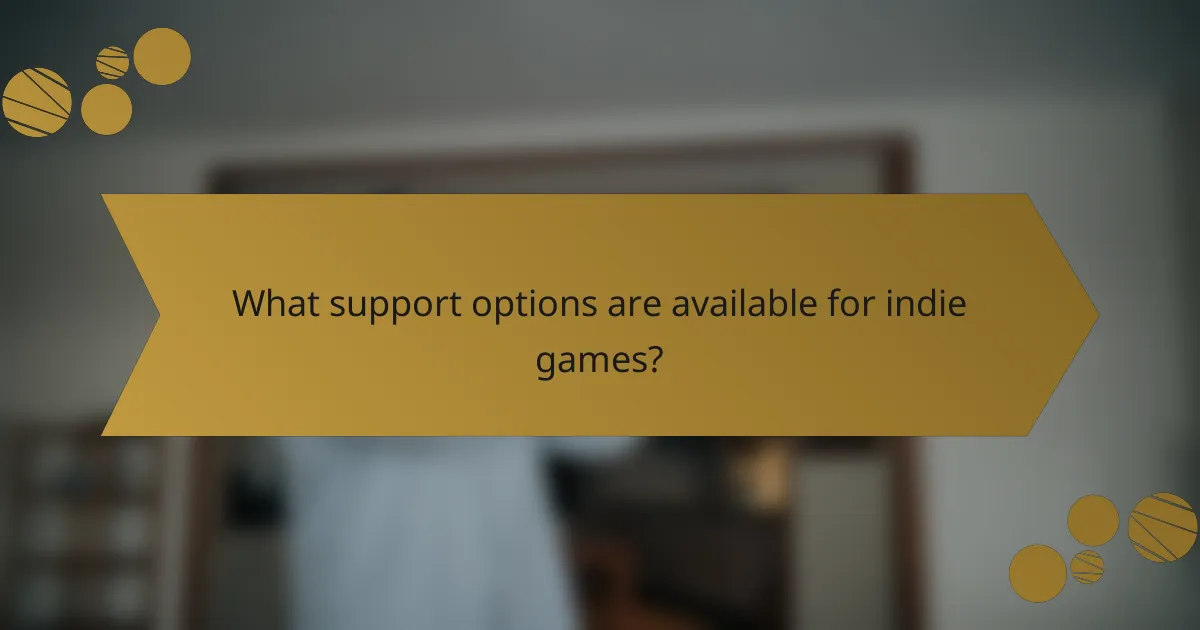
What support options are available for indie games?
Indie games often have limited support options compared to larger titles, but several avenues exist for players seeking assistance. These options include community forums, social media platforms, and dedicated support channels from developers.
Join indie game development forums
Participating in indie game development forums can provide valuable insights and support. These forums often feature discussions on troubleshooting, gameplay tips, and updates directly from developers. Popular forums include TIGSource and IndieDB, where users can share experiences and solutions.
When joining these forums, be sure to read the community guidelines and actively engage with other members. This can enhance your understanding of the game and foster connections with developers and fellow players.
Utilize platforms like Discord for support
Discord has become a popular platform for indie game communities, offering real-time communication and support. Many indie games have dedicated servers where players can ask questions, report bugs, and receive updates directly from developers.
To effectively use Discord for support, join the relevant server and familiarize yourself with the channels available. Look for channels specifically designated for support or feedback, and don’t hesitate to ask questions. Engaging with the community can lead to quicker resolutions and a more enjoyable gaming experience.
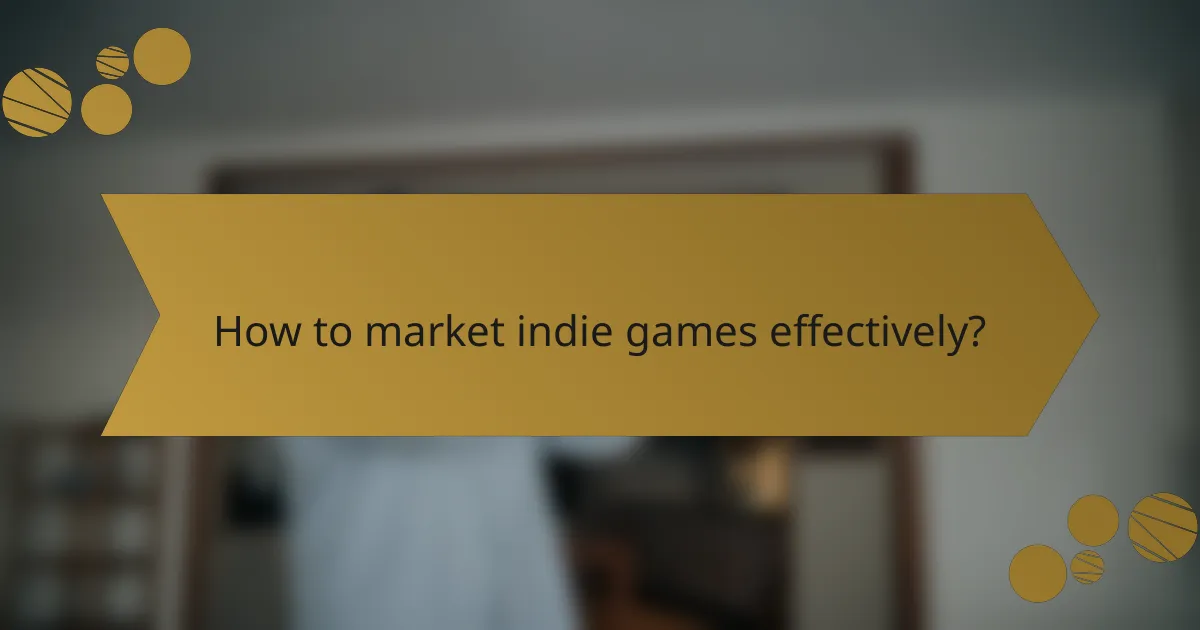
How to market indie games effectively?
Marketing indie games effectively involves utilizing various strategies to reach your target audience and build a community around your game. Focus on leveraging social media, engaging with influencers, and participating in gaming conventions to enhance visibility and support.
Leverage social media platforms
Social media platforms like Twitter, Instagram, and TikTok are essential for indie game marketing. Create engaging content that showcases gameplay, artwork, and development updates to attract potential players. Use relevant hashtags to increase visibility and connect with gaming communities.
Consider running targeted ads on these platforms to reach specific demographics. A budget of a few hundred dollars can yield significant engagement if aimed at the right audience. Regular interaction with followers can also foster loyalty and encourage word-of-mouth promotion.
Engage with gaming influencers
Collaborating with gaming influencers can significantly boost your game’s exposure. Identify influencers whose audience aligns with your target market and reach out for partnerships, such as gameplay videos or reviews. This can create authentic buzz around your game.
Offer influencers early access to your game or exclusive content to incentivize their promotion. Keep in mind that micro-influencers, who have smaller but highly engaged audiences, can often provide a better return on investment compared to larger influencers.
Participate in gaming conventions
Attending gaming conventions is a powerful way to showcase your indie game directly to players and industry professionals. Events like PAX, IndieCade, or Gamescom provide opportunities for hands-on demos and networking. Prepare promotional materials and demos to leave a lasting impression.
Consider applying for awards at these conventions, as recognition can enhance credibility and attract media attention. Budget for travel and accommodation, as these events can be costly but often lead to valuable connections and increased visibility for your game.

What are the challenges of niche appeal in indie games?
Niche appeal in indie games often leads to challenges such as limited audience reach and difficulty in monetization. These factors can significantly impact the success and sustainability of indie titles in a competitive market.
Limited audience reach
Indie games with niche appeal typically attract a smaller, more specific audience. This limited reach can hinder visibility, making it harder for developers to gain traction in a crowded marketplace. For instance, a game centered on a unique cultural theme may resonate with a specific demographic but struggle to attract broader interest.
To address this, developers should consider targeted marketing strategies. Engaging with communities on platforms like Discord or Reddit can help build a loyal fanbase. Additionally, leveraging social media to showcase unique aspects of the game can enhance visibility among potential players.
Difficulty in monetization
Monetizing niche indie games can be challenging due to their limited audience. Developers may find it difficult to set a price point that reflects the game’s value while still appealing to a small group of players. For example, a game priced at $20 may be too high for a niche audience that typically expects lower prices.
To improve monetization prospects, indie developers can explore various revenue models. Offering a pay-what-you-want option or implementing in-game purchases can provide flexibility. Additionally, crowdfunding platforms like Kickstarter can help gauge interest and secure funding before the game’s release.

How to choose the right indie game platform?
Selecting the right indie game platform involves understanding the target audience, revenue models, and the overall support ecosystem. A well-chosen platform can enhance visibility and profitability while aligning with the game’s niche appeal.
Evaluate platform audience demographics
Understanding the demographics of a platform’s audience is crucial for indie game developers. Platforms like Steam cater to a broad audience, while others like itch.io attract niche gamers who appreciate experimental titles. Analyze age, interests, and gaming habits to ensure your game resonates with the intended players.
Consider using analytics tools or platform reports to gather data on user demographics. This information can guide your marketing strategies and help you tailor your game to meet audience expectations, increasing the chances of success.
Consider platform revenue models
Different platforms operate on various revenue models, which can significantly impact your earnings. Common models include revenue sharing, subscription fees, and upfront purchases. For instance, platforms like Epic Games Store offer a higher revenue share to developers compared to Steam, which takes a percentage of sales.
Evaluate the financial implications of each model. If your game has a niche appeal, a platform with lower fees might be more beneficial, allowing you to retain more revenue. Always read the fine print regarding payment schedules and any additional costs associated with publishing your game.

What are the benefits of indie game collections?
Indie game collections offer unique advantages, including a wide variety of gameplay experiences and the opportunity to support independent developers. These collections often showcase innovative titles that might not receive mainstream attention, making them appealing to niche audiences.
Diverse gameplay experiences
Indie game collections feature a broad spectrum of gameplay styles, from platformers to narrative-driven adventures. This diversity allows players to explore different mechanics and storytelling approaches that are often absent in mainstream titles.
For example, a collection might include a puzzle game, a roguelike, and a visual novel, providing players with varied experiences in a single package. This variety can enhance replayability and keep players engaged for longer periods.
Support for independent developers
Purchasing indie game collections directly supports independent developers, who often face challenges in funding and marketing their projects. By buying these collections, players contribute to the sustainability of the indie game scene, allowing developers to create more innovative titles.
Additionally, many collections include behind-the-scenes content or developer commentary, giving players insight into the creative process. This connection can foster a sense of community and appreciation for the hard work that goes into making indie games.
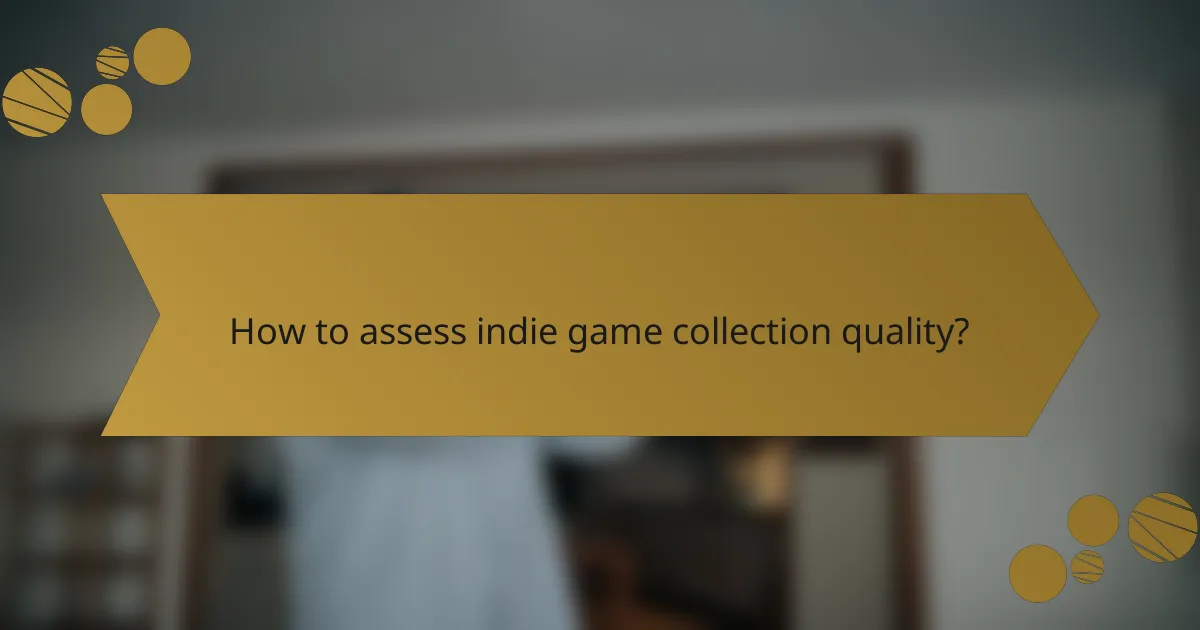
How to assess indie game collection quality?
To assess the quality of an indie game collection, focus on user ratings, reviews, and the overall support provided by developers. These factors can help you gauge the reliability and enjoyment of the games in the collection.
Review user ratings and reviews
User ratings and reviews are essential for evaluating the quality of indie games. Look for games with a high average rating, typically above 70% on platforms like Steam or Metacritic, as this often indicates a positive reception. Pay attention to the number of reviews as well; a game with a few glowing reviews may not be as reliable as one with hundreds.
When reading reviews, consider both positive and negative feedback. Positive reviews can highlight enjoyable gameplay mechanics, while negative reviews may reveal issues such as bugs or lack of content. Look for recurring themes in the comments to identify common strengths or weaknesses.
Additionally, check for recent reviews to ensure the game is still well-supported. Games that receive regular updates and community engagement from developers are often more reliable choices, as they indicate ongoing commitment to quality and player satisfaction.
